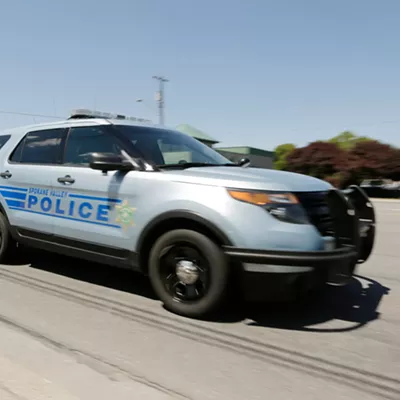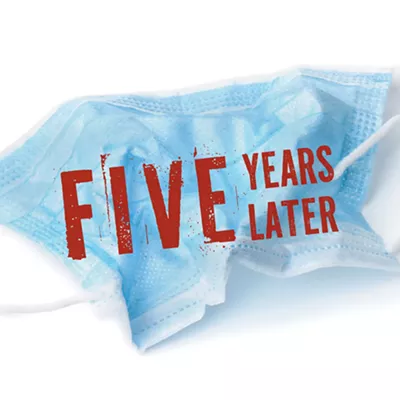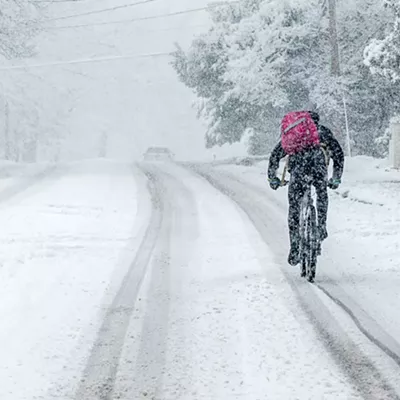The 1990s were a different, some say glorious, time. Or were they? On April 23, 1997, we had a cover story about trouble brewing on Moran Prairie, aka south Spokane, with its growing congestion and flooded basements. We used the word NIMBY, a term that nowadays has become common here and, well, everywhere. A few months later, on Sept. 24, 1997, we published another cover story titled, "Why SUVs Suck," all about how bigger and bigger cars are making our streets more and more dangerous. That's a topic we just wrote about again this year — 26 years later — because, I guess, the '90s are cool again?
IN THE NEWS
On Feb. 19, 1997, longtime Inlander columnist Bob Herold took his first aim at plans for a LINCOLN STREET BRIDGE. If you haven't heard of it, that's because Herold had particularly good aim. It was a terrible idea. City leaders and some downtown property owners hatched plans to convert the Monroe Street Bridge into a four-lane span for one-way traffic, and paired it with a new bridge — right over the Spokane Falls — of equally/disastrously wide one-way traffic. In a big, newsy cover story on July 23, 1997, we questioned the project, in the story and in our headline, "Bridge over the river, why?" Thanks to Herold's dogged coverage, and lots of lovers of the Falls, the Lincoln bridge was quietly scuttled.
CULTURE BEAT
In 1998, members of the various Inland Northwest tribes and other Native and Indigenous people came together to hold the first modern JULYAMSH POWWOW. The sharing of Indigenous culture — through dance, music, food, history and more — was the "ultimate summer festival gathering" and better than any "Lollapalooza-fest-o-ramas," as local author Kris Dinnison wrote in our pages back then. Laura Stensgar, who was marketing director of what was then called the Coeur d'Alene Tribal Bingo-Casino, said it was "the nation's largest outdoor powwow." (Today, she's Laura Penney, CEO of the Coeur d'Alene Casino Resort Hotel.) Powered by the leadership of then-CEO David Matheson, Julyamsh grew and grew, but it hasn't been held since the pandemic. But the sharing of Native culture has continued. Matheson, who was also a pioneer in bringing tribal gaming to the Inland Northwest, died earlier this year, as his casino celebrated 30 years.
ON THE COVER
Remember when Avista was called Washington Water Power? That was the topic of "HASTA L'AVISTA," a big story in the Dec. 16, 1998, issue that explored the growing trend of deregulation in the energy industry. Local WWP investors fretted about losing "Washington" in the name, worrying the new moniker was a harbinger of less local control. They had good reason to worry: The deregulation that led to the Avista name also led to Enron, the Texas-based company that was the darling of financiers before it was revealed that the company, valued at $101 billion, was engaged in accounting fraud. That company's eventual bankruptcy sent shocks through the world economy. In the meantime, Avista is still headquartered in Spokane and sends shocks — I mean electricity — to hundreds of thousands of people in Washington, Idaho and Oregon.
LOCAL FOLKS
Reading a recent edition of the Inlander, you won't be surprised to see the names NADINE WOODWARD or LISA BROWN. One's the mayor of Spokane, and the other wants to be, after all. But in 1997? On March 26 of that year, the results of our long running Best Of contest were published. Woodward was there, in the midst of a hot streak as the "best local newscaster." She'd already won twice, and we noted that "this woman just can't lose these days." A page later, over in the "best local public official" category, Brown appears, placing third behind John Roskelley and George Nethercutt. Those two guys are out of politics, but Brown keeps going, though we'd like to update the descriptor we gave her back then: "mom-with-an-attitude-for-social-justice."
























